情态动词(1) 2
情态动词的用法 完整版
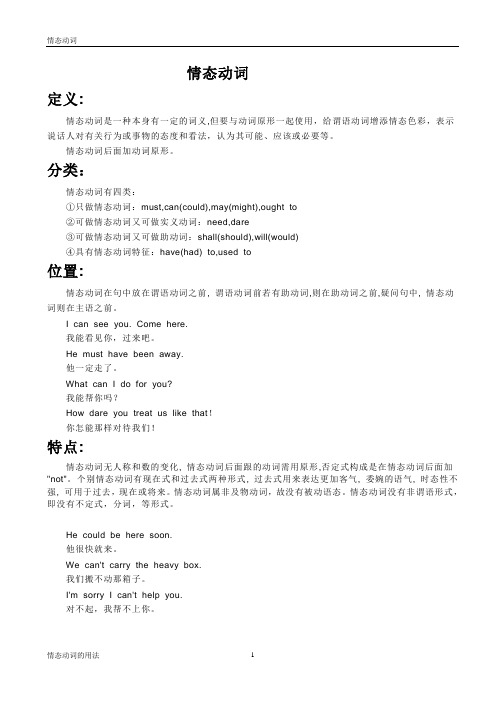
情态动词定义:情态动词是一种本身有一定的词义,但要与动词原形一起使用,给谓语动词增添情态色彩,表示说话人对有关行为或事物的态度和看法,认为其可能、应该或必要等。
情态动词后面加动词原形。
分类:情态动词有四类:①只做情态动词:must,can(could),may(might),ought to②可做情态动词又可做实义动词:need,dare③可做情态动词又可做助动词:shall(should),will(would)④具有情态动词特征:have(had) to,used to位置:情态动词在句中放在谓语动词之前, 谓语动词前若有助动词,则在助动词之前,疑问句中, 情态动词则在主语之前。
I can see you. Come here.我能看见你,过来吧。
He must have been away.他一定走了。
What can I do for you?我能帮你吗?How dare you treat us like that!你怎能那样对待我们!特点:情态动词无人称和数的变化, 情态动词后面跟的动词需用原形,否定式构成是在情态动词后面加"not"。
个别情态动词有现在式和过去式两种形式, 过去式用来表达更加客气, 委婉的语气, 时态性不强, 可用于过去,现在或将来。
情态动词属非及物动词,故没有被动语态。
情态动词没有非谓语形式,即没有不定式,分词,等形式。
He could be here soon.他很快就来。
We can't carry the heavy box.我们搬不动那箱子。
I'm sorry I can't help you.对不起,我帮不上你。
基本助动词与情态助动词最主要的区别之一是,基本助动词本身没有词义,而情态助动词则有自己的词义,能表示说话人对有关动作或状态的看法,或表示主观设想:What have you been doing since? (构成完成进行体,本身无词义)I am afraid I must be going. (一定要)You may have read some account of the matter. (或许已经)除此之外,情态助动词还有如下词法和句法特征:1)除ought和used以外,其他情态动词后面只能接不带to的不定式。
情态动词(1)
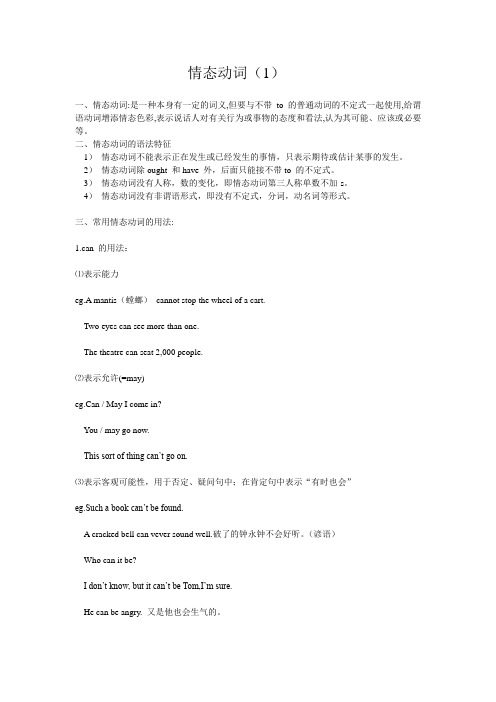
情态动词(1)一、情态动词:是一种本身有一定的词义,但要与不带to的普通动词的不定式一起使用,给谓语动词增添情态色彩,表示说话人对有关行为或事物的态度和看法,认为其可能、应该或必要等。
二、情态动词的语法特征1)情态动词不能表示正在发生或已经发生的事情,只表示期待或估计某事的发生。
2)情态动词除ought 和have 外,后面只能接不带to 的不定式。
3)情态动词没有人称,数的变化,即情态动词第三人称单数不加-s。
4)情态动词没有非谓语形式,即没有不定式,分词,动名词等形式。
三、常用情态动词的用法:1.can 的用法:⑴表示能力eg.A mantis(螳螂)cannot stop the wheel of a cart.Two eyes can see more than one.The theatre can seat 2,000 people.⑵表示允许(=may)eg.Can / May I come in?You / may go now.This sort of thing can’t go on.⑶表示客观可能性,用于否定、疑问句中;在肯定句中表示“有时也会”eg.Such a book can’t be found.A cracked bell can vever sound well.破了的钟永钟不会好听。
(谚语)Who can it be?I don’t know, but it can’t be Tom,I’m sure.He can be angry. 又是他也会生气的。
⑷表示惊异、怀疑、不相信等态度,主要用于否定、疑问或惊叹句中eg.No,no,this can’t be true.What can he mean?How can you be so careless?*在表示能力时,be able to 等于can ,但是前者有更多的时态形式,并且强调能而做到,后者只表示能力是否达到eg.I’m sorry I haven’t been able to answer your letter.She sai she had never been able to come earlier.She said she would be able to persuaded her husband to abandon smoking.2.could的用法⑴作为can 的过去式形式,表示过去的能力、可能性、允许等eg.He said too fast. Could you catch what he said?Before liberation,few workers could support their families.She asked whether she could take the book out of the room.⑵比较委婉的提出问题或陈述看法,这时没有时间上的差别eg.Could you tell me the way to the Children’s Palace?I could come earlier if necessary.I’m afraid I couldn’t give you an answer today.⑶用在虚拟语气中构成谓语eg.I would help you if I could.If you had tried harder you could have overcome the difficulties.We would be much obliged if you could send us a sample.3.may的用法⑴询问或说明一件事可不可以做,即表示许可eg.May I trouble you with a question?You may take this seat if you like.May I smoke here?Yes, ple ase. / No,you mustn’t.Please may not pick flowers in the garden.⑵表示可能性/ 推测eg.He may be busy now.A fool may give a wise man councel. 傻子也能改聪明人出主意。
人教版高中英语教材语法知识点分布(1-8)

情态动词2:
oughtto/oughtnotto/haveto/don’thaveto/mustn’t/needn’t
第三单元
名词性从句1:作为宾语和表语
第四单元
名词性从句2:作为主语
第五单元
名词性从句3:作为同位语
必修四
单元
语法点
第一单元
主谓一致
第二单元
非谓语动词:ing形式作主语和宾语
第三单元
语法点
第一单元
虚拟语气1:
Iwish,Icould/did/would…
IfIdid…,Iwoulddo…
第二单元
虚拟语气2:
IfIhaddone…,Iwouldhavedone…
第三单元
It的特殊用法(1)
第四单元
It的特殊用法(2)
第五单元
复习ing形式
高二年级下学期
选修七
单元
语法点
第一单元
复习不定式
人教版高中英语语法知识点分布一览表
高一年级上学期
必修一
单元
语法点
第一单元
直接引语间接引语1:陈述句和疑问句
第二单元
直接引语间接引语2:请求和命令
第三单元
时态:现在进行时表将来
第四单元
定语从句1:that,which,whom,whose
第五单元
定语从句2:when,where,why,介词+which/whom
非谓语动词:ing形式作表语、定语和宾语补足语
第四单元
非谓语动词:ing形式作定语和状语
第五单元
合成词
高二年级上学期
必修五
单元
语法点
第一单元
情态动词 (1)

情态动词用法归纳(1)may和might常表示肯定没有多大把握的推测,只是具有事实上的可能性。
I go shopping tomorrow.明天我有可能去购物。
(表示动作有可能发生)He be our history teacher.他可能是我们的历史老师。
It rain later this afternoon.今天下午有可能会下雨。
(表示预测)(2)can和could多用于否定句和疑问句中。
他不可能是个学生。
He a student.Anybody make mistakes.任何人都会犯错。
(只表示理论上的可能性)他现在可能在家吗?he be at home now?(3)shall和should用于表示“必定,应该”。
总有一天我会发达的。
I _____ be rich one day.那应该是汤姆的错了。
That _____ _____ Tom’s mistake.(4)must用来表示非常有把握的推测。
这肯定对你有好处。
This _____ be good for you.人肯定都要死的。
All mankind ______ ______.总结:可能性逐渐递增的顺序为:might<may<could<can<should<shall<must。
(1)can和could可用来表示“许可”,也可用来表示“请求”。
我能借用一下你的自行车吗?_____ _____ borrow your bike? (请求)你可以坐在这儿。
You ______ sit here. (许可)我可以问你一个问题吗?_______ I ask you a question? (表请求,比can更委婉)(2)will和would用来表示“请求”。
请你告诉我去医院的路好吗?_______ you tell me the way to the hospital?你帮我一把好吗?_________ you give me a hand?(3)shall和should用于第一人称,表示征询对方意见。
情态动词(用法)(一)

高中英语语法Modal Verb(情态动词)情态动词表示说话人的某种情感表态:(1)can表示能力,意为“会”“能”例:He can speak English now.他现在能说英语了。
(2)can表示“允许”或“请求允许”,意为“可以”例:can I use your phone?我可以用一下你的电话吗?(3)can表示说话人的猜测,用来表示惊讶,怀疑,不相信等态度,主要用于否定句和疑问句。
例:I believe that she can`t be so careless.(对现在进行推测)我相信她不会如此粗心。
例:What can he be being ?(对现在发生的事进行推测)他会在干什么?例:The ground isn`t wet, it can`t have rained last night.(对过去发生的事进行推测)地面未湿,昨晚上肯定没下雨。
Be able to表示“能力”,如果只表示能力时,两者都可用,但若表示经历一定的挫折打击,终于能够怎么样,过去的能力+特定行为时,则要用 was/were able to(1)现在时,两者皆可能,例:I can/am able to swim 我会游泳。
(2)用于表示过去的能力,两者皆可用。
例:When he was three he could/wasable to swim.当他3岁就会游泳了。
(3)表示将来的能力不能用can, The baby will be able to walk in a few weeks.这个婴儿用了几个星期就会走路了。
(4)他能够而且的确去了,只能用was able to. His mother wasn`t at home, sohe was able to go to see the film. 他的妈妈不在家,因此他就去看电影了。
(5)Be able to 还可以用于完成时态,而can不能。
情态动词用法归纳(全)(1)
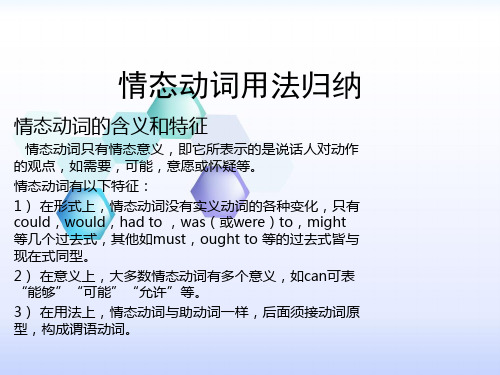
2) need 作情态动词用时, 常用于疑问句、否定句。在肯定句 中一般用must, have to, ought to, should代替。
1.You needn’t come so early. 2. ---- Need I finish the work today?
---- Yes, you must. / No, you needn’t.
may(might)有以下几种形式:
时态 现在式 过去式
肯定式 may might
否定式 缩略否定式
may not
mayn't
might not mightn't
may(might)的基本用法:
1)表可能,暗含不确定,等于possibly,perhaps,maybe,如: He may be busy getting ready for his trip. 他也许在忙于准备外出旅游。
You might ask before you borrow my car. 你可以先问问我再借我的车子嘛。
you might have helped me. 你完全可以帮我一把的呀。
4)May 与might的比较:
might 可表虚拟语气,may则不可以,如: It might help a little if you would only keep clean .
He should do some work,but he doesn't want to 他应该做些工作,但是他不想做。
4)表推测,暗含很大的可能,如:
The film should be very good as it is starring first-class actors. 这部电影是一流的演员主演的,可能拍得很好。
情态动词用法(1)

初中范围内要求掌握的情态动词
1. can的用法: (1).表示能力. 此时may和must均不可代替它。 如:She can swim fast, but I can’t. (2).表示请求, 许可,常在口语中。如:Can I use your pen? You can use my dictionary. (3) .表示推测,意为“可能”,常用于否定句和疑问句 中,此时can’t译为“不可能”。如: Can the news be true? —Can it be our teacher?—No, it can’t be our teacher. He is on a visit to the Great Wall.
7. should的用法:
should意为“应该”,可表示劝告、建议、义务、 责任等。与ought to基本同义, 可互换。如: We should protect the environment.
5. need的用法:
(1).need表示需要、必须,主要用于否定句和疑 问句中,其否定形式为needn’t,意为“没有必要, 不必”。用need提问时,肯定回答为must,否定 回答为needn’t或don’t have to。如: —Need I stay here any longer? —Yes, you must ./—No. you needn’t /don’t have to. (2).need还可以作实义动词,此时有人称、数和时 态的变化,如果是人作主语后边多接动词不定式。 如: I need to do it right now. He needs to learn more about the girl.
英语情态动词用法详解(1)

英语情态动词用法详解(1)一、单项选择情态动词1.I ______ worry about my weekend—I always have my plans ready before it comes. A.can’t B.mustn’t C.daren’t D.needn’t【答案】D【解析】【详解】考查情态动词。
句意:我没有必要担心我的周末,我总是在周末到来之前做好计划。
A. can’t 不可能;B. mustn’t禁止;C. daren’t不敢; D .needn’t没有必要。
由“I always have my plans ready before it comes ”可知,needn’t “没有必要” 符合句意。
故选D。
2.Keep up your spirits even if you _____ fail hundreds of times.A.must B.needC.may D.should【答案】C【解析】【详解】考查情态动词。
A. must必须;B. need需要;C. may可能,或许;D. should应该。
句意:即使失败了几百次,也要振作起来。
此处表示一种不确定的推测,故选C。
3.It has been announced that all the candidates ___________ remain in their seats until all the papers have been collected.A.shall B.couldC.would D.ought【答案】A【解析】【详解】考查情态动词用法。
句意:据宣布,所有的候选人都要坐在位置上,直到所有的试卷都被收齐。
根据句意可知本句是考试规则,情态动词shall可以表示“按照规则/规定/法律要做的事情”,符合本句语境。
故A项正确。
4.he law is equally applied to everyone. No one _______ be above it.A.shall B.mustC.may D.need【答案】A【解析】【详解】考查情态动词。
小六英语第11讲:情态动词(1)
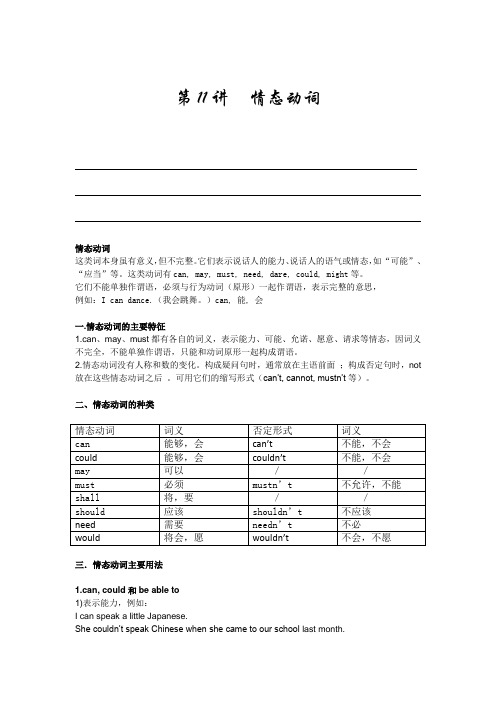
第11讲情态动词情态动词这类词本身虽有意义,但不完整。
它们表示说话人的能力、说话人的语气或情态,如“可能”、“应当”等。
这类动词有can, may, must, need, dare, could, might等。
它们不能单独作谓语,必须与行为动词(原形)一起作谓语,表示完整的意思,例如:I can dance.(我会跳舞。
)can, 能, 会Be able to代替can, 也可以表示能力。
但can只有一般现在时和一般过去时(could), 而be able to则有更多的时态形式,例如:My little brother has been able to write.2)表示允许,准许,这时can与may可以互换,例如:Can/May I borrow your bike tomorrow?Yes, of course. You can/may use my bike tomorrow.You can’t smoke here.表示请求时肯定的回答方式有:Yes, you can.∕Of course.∕ Certainly. ∕Sure否定回答方式有:No, you can’t∕ No,you mustn’t.3)表示客观可能性,用在否定句和疑问句中表示说话人的怀疑、猜测或不肯定。
例如:He cannot/can’t be there.Can this news be true?4)could除表示can的过去式外,在口语中还常代替can,表示非常委婉的请求。
这时could和can没有时间上的差别。
例如:Could/Can you tell me if he will go tomorrow?Could/Can I ask you something if you are not busy?2.may和might1)表示“准许”和“许可”,这时可与can替换。
例如:May (can) I use your dictionary for a moment?May I take these magazines out of the reading r oom? No, you mustn’t.2)表示说话人的猜测,认为某事“可能”发生,例如:Where’s John? He may be at the library.Mr. Green hasn’t talked with her. He may not know her.He may be at home.Maybe he was at home.3)might除表示may的过去式外,在口语中还常代替may, 表示非常委婉的请示或实现的可能性较小。
最全情态动词归纳和总结

一:什么是情态动词?情态动词表示说话人对某一动作或状态的态度。
二:情态动词的特点1)有一定词义;2)不受主语人称和数的变化影响;3)与主要动词的原形(或称不带to的不定式)一起构成谓语(除ought to作固定词组看待)。
三:情态动词的基本用法1. can (could)1)表示能力,could主要指过去时间。
Two eyes can see more than one. 两只眼比一只眼看得清。
Could the girl read before she went to school? 这女孩上学前能识字吗?2)表示可能(理论上或是逻辑判断上)。
The temperature can fall to –60℃, that is 60℃ below freezing.气温可降至—60℃,也就是零下60℃。
He can’t (couldn’t) have enough money for a new car. 他不可能有足够的钱买新车。
You mustn't smoke while you're walking around in the wood. You could start a fire. 在林子里走时勿吸烟,那样可能会引起火灾。
3)表示允许。
Can I have a look at your new pen? 我可以看一看你的新钢笔吗?He asked whether he could take the book out of the reading-room.他问他可不可以把书带出阅览室。
4)表惊异、怀疑、不相信等态度。
主要用于否定句、疑问句或感叹句中。
Where can (could) they have gone to? 他们会去哪儿了呢?He can’t (couldn’t) be over sixty. 他不可能超过六十岁。
How can you be so careless? 你怎么这么粗心?5)比较委婉客气地提出问题或陈述看法。
英语情态动词用法详解(1)
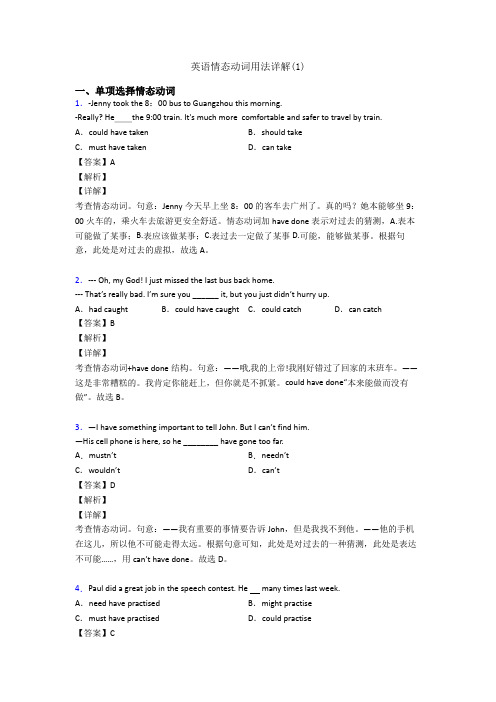
英语情态动词用法详解(1)一、单项选择情态动词1.-Jenny took the 8:00 bus to Guangzhou this morning.-Really? He__the 9:00 train. It's much more comfortable and safer to travel by train. A.could have taken B.should takeC.must have taken D.can take【答案】A【解析】【详解】考查情态动词。
句意:Jenny今天早上坐8:00的客车去广州了。
真的吗?她本能够坐9:00火车的,乘火车去旅游更安全舒适。
情态动词加have done表示对过去的猜测,A.表本可能做了某事;B.表应该做某事;C.表过去一定做了某事D.可能,能够做某事。
根据句意,此处是对过去的虚拟,故选A。
2.--- Oh, my God! I just missed the last bus back home.--- That’s really bad. I’m sure you ______ it, but you just didn’t hurry up.A.had caught B.could have caught C.could catch D.can catch【答案】B【解析】【详解】考查情态动词+have done结构。
句意:——哦,我的上帝!我刚好错过了回家的末班车。
——这是非常糟糕的。
我肯定你能赶上,但你就是不抓紧。
could have done“本来能做而没有做”。
故选B。
3.—I have something important to tell John. But I can’t find him.—His cell phone is here, so he ________ have gone too far.A.mustn’t B.needn’tC.wouldn’t D.can’t【答案】D【解析】【详解】考查情态动词。
英语语法情态动词归纳总结(1)

英语语法情态动词归纳总结(1)一、单项选择情态动词1.-–Mary knows the city quite well.--She______ well have been there before.A.need B.could C.should D.may【答案】D【解析】【分析】【详解】考查情态动词辨析。
句意:——Mary非常了解这个城市。
——她肯定以前在那里呆过。
may have done过去可能做过某事。
表示对过去的肯定猜测。
need have done本需要做某事却没做;could have done本可以做某事却没做;should have done本应该做某事却没做。
故选D。
2.-- Did Jim come?-- I don’t know. He _______ while I was out.A.might have come B.might comeC.must have come D.should have come【答案】A【解析】【详解】考查情态动词推测用法。
句意:Jim来了吗?--我不知道,在我不在的时候,可能来过。
根据前文I don’t kn ow.可知,说话者不知道Jim来没来,因此后文推测来过,但是语气很不确定,故可知选A。
对过去情况的推测为情态动词+have done,must have done 一定做了某事,should have done 应该来过,不符合,故选A。
【点睛】情态动词+have+过去分词的用法,表示推测或判断过去的情况。
can/could+have+过去分词用法:①多用于否定句和疑问句中。
表示对过去某事发生的可能性的否定或质疑,意为:不可能(已经)......了-(否定句)/可能(已经)......了嘛?-(疑问句)②用于肯定句中。
表示对过去没有做某事的遗憾,含有轻微的责备,意为:本来可以......的(但实际上没有......)。
You could have done better, but you were too careless.(肯定句。
情态动词的用法
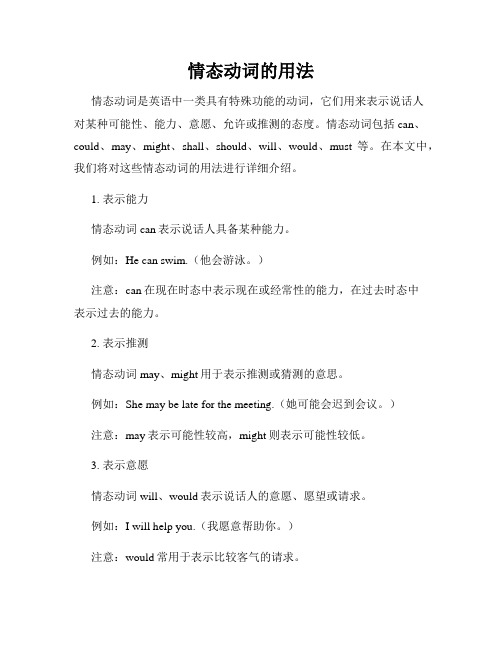
情态动词的用法情态动词是英语中一类具有特殊功能的动词,它们用来表示说话人对某种可能性、能力、意愿、允许或推测的态度。
情态动词包括can、could、may、might、shall、should、will、would、must等。
在本文中,我们将对这些情态动词的用法进行详细介绍。
1. 表示能力情态动词can表示说话人具备某种能力。
例如:He can swim.(他会游泳。
)注意:can在现在时态中表示现在或经常性的能力,在过去时态中表示过去的能力。
2. 表示推测情态动词may、might用于表示推测或猜测的意思。
例如:She may be late for the meeting.(她可能会迟到会议。
)注意:may表示可能性较高,might则表示可能性较低。
3. 表示意愿情态动词will、would表示说话人的意愿、愿望或请求。
例如:I will help you.(我愿意帮助你。
)注意:would常用于表示比较客气的请求。
4. 表示推测的过去情态动词must常用于表示对过去情况的推测或肯定。
例如:He must have missed the bus.(他肯定错过了公交车。
)注意:must用于表示对过去情况的肯定,而might用于表示对过去情况的推测。
5. 表示义务或必要性情态动词must表示对义务、必要性或确定性的肯定。
例如:You must finish your homework.(你必须完成作业。
)6. 表示建议或应该情态动词should表示建议或应该。
例如:You should go to bed early.(你应该早点睡觉。
)注意:should还可以表示对过去情况的推测,例如:He should have arrived by now.(他现在应该已经到达了。
)7. 表示允许或许可情态动词can与may可以用于表示许可或允许。
例如:Can I borrow your pen?(我可以借你的钢笔吗?)8. 表示可能性情态动词could用于表示可能性。
情态动词
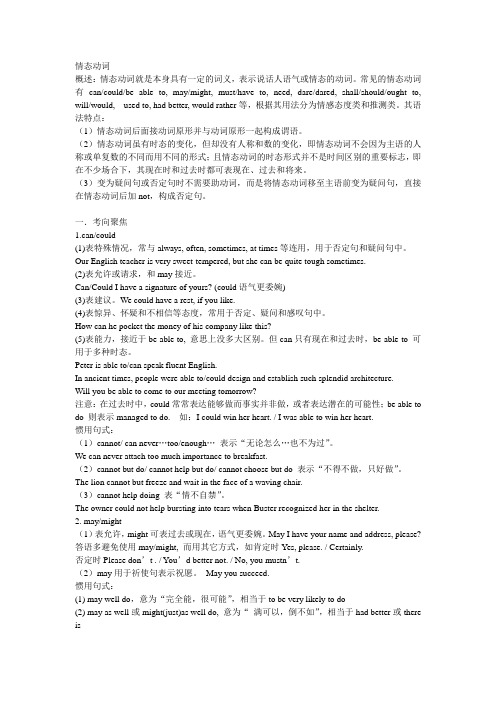
情态动词概述:情态动词就是本身具有一定的词义,表示说话人语气或情态的动词。
常见的情态动词有can/could/be able to, may/might, must/have to, need, dare/dared, shall/should/ought to, will/would, used to, had better, would rather等,根据其用法分为情感态度类和推测类。
其语法特点:(1)情态动词后面接动词原形并与动词原形一起构成谓语。
(2)情态动词虽有时态的变化,但却没有人称和数的变化,即情态动词不会因为主语的人称或单复数的不同而用不同的形式;且情态动词的时态形式并不是时间区别的重要标志,即在不少场合下,其现在时和过去时都可表现在、过去和将来。
(3)变为疑问句或否定句时不需要助动词,而是将情态动词移至主语前变为疑问句,直接在情态动词后加not,构成否定句。
一.考向聚焦1.can/could(1)表特殊情况,常与always, often, sometimes, at times等连用,用于否定句和疑问句中。
Our English teacher is very sweet-tempered, but she can be quite tough sometimes.(2)表允许或请求,和may接近。
Can/Could I have a signature of yours? (could语气更委婉)(3)表建议。
We could have a rest, if you like.(4)表惊异、怀疑和不相信等态度,常用于否定、疑问和感叹句中。
How can he pocket the money of his company like this?(5)表能力,接近于be able to, 意思上没多大区别。
但can只有现在和过去时,be able to 可用于多种时态。
Peter is able to/can speak fluent English.In ancient times, people were able to/could design and establish such splendid architecture.Will you be able to come to our meeting tomorrow?注意:在过去时中,could常常表达能够做而事实并非做,或者表达潜在的可能性;be able to do 则表示managed to do. 如:I could win her heart. / I was able to win her heart.惯用句式:(1)cannot/ can never…too/enough…表示“无论怎么…也不为过”。
助动词和情态动词的用法总结-V1
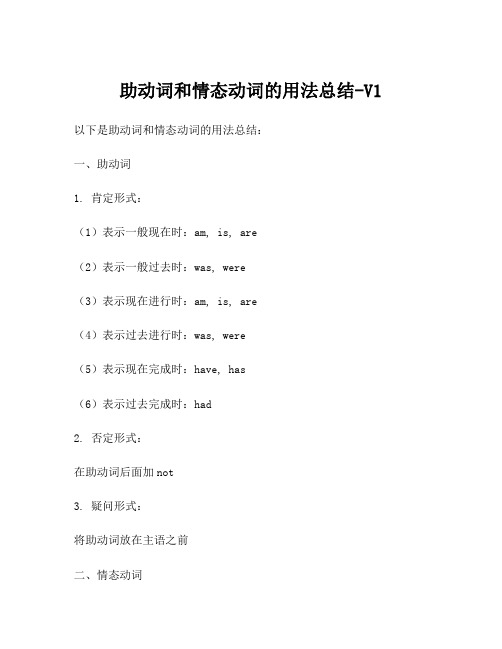
助动词和情态动词的用法总结-V1以下是助动词和情态动词的用法总结:
一、助动词
1. 肯定形式:
(1)表示一般现在时:am, is, are
(2)表示一般过去时:was, were
(3)表示现在进行时:am, is, are
(4)表示过去进行时:was, were
(5)表示现在完成时:have, has
(6)表示过去完成时:had
2. 否定形式:
在助动词后面加not
3. 疑问形式:
将助动词放在主语之前
二、情态动词
(1)表示“可能性、能力、许可性、必然性、意愿、建议、命令”等意义
(2)能够强调语气、表达说话人的态度和情感
(3)情态动词后面跟动词原形
常见情态动词:
1. can:能够,会
2. could:能够,可以(过去式)
3. may:可能,可能性
4. might:可能,也许(过去式)
5. must:必须,一定
6. shall:将,应该
7. should:应该,应当
8. will:将会,愿意
9. would:会,愿意,宁愿(过去式)
以上是助动词和情态动词的用法总结。
在日常英语学习中,助动词和情态动词的使用频繁,需要多加练习并注意它们的特点和用法。
情态动词用法详解(1)

1. 与第一人称连用,表示意愿,同意,提议或允许. All right, I‟ll come. 2. 与第二人称连用,表客气的请求. Will you please telephone me later? 3. 用于否定句表拒绝 This window won‟t open. 4. 某人有做某事的习惯,某事自然会如何或在预料之 中 The boy would play a trick on his parents when he was a child.
should
1)预测、可能。
They should be here by now.
2)说话人的感情。如惊奇、愤怒、失望等、 “竟然” You can‟t imagine that well-behaved gentleman should be so rude to a lady.
will 和would
他不敢告诉老师那天发生的事。
1. ought “应当;应该”,后面跟带有 to 的动词不定式。 You ought to read these books if you want to know how to repair the motorcar. 如果你想知道如何修理汽车,你应该读这些书。 You ought to bring the child here. 你应该把孩子带来。
情态动词无人称和数的变化,情态动词后面跟的动词需用原形, 否定式构成是在情态动词后面加“not”。个别情态动词有现在式和 过去式两种形式,过去式可以用来表达更加客气、委婉的语气,时 态性不强,可用于过去,现在或将来。 He could be here soon. 他很快就来。 We can't carry the heavy box. 我们搬不动那箱子。 I'm sorry I can't help you. 对不起,我帮不上你。
情态动词用法总结归纳
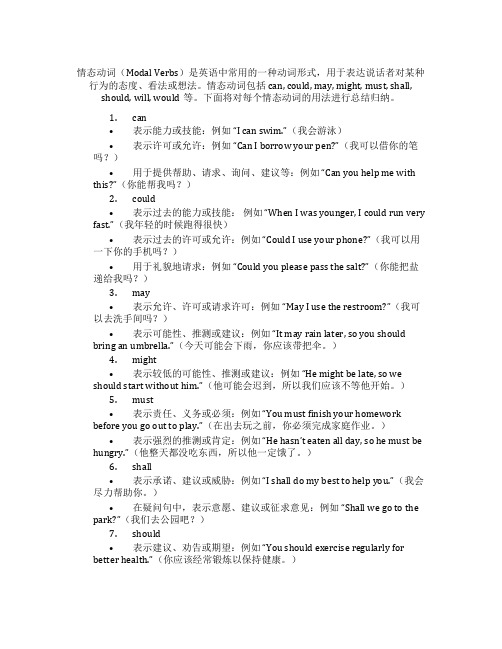
情态动词(Modal Verbs)是英语中常用的一种动词形式,用于表达说话者对某种行为的态度、看法或想法。
情态动词包括can, could, may, might, must, shall, should, will, would等。
下面将对每个情态动词的用法进行总结归纳。
1.can•表示能力或技能:例如“I can swim.”(我会游泳)•表示许可或允许:例如“Can I borrow your pen?”(我可以借你的笔吗?)•用于提供帮助、请求、询问、建议等:例如“Can you help me with this?”(你能帮我吗?)2.could•表示过去的能力或技能:例如“When I was younger, I could run very fast.”(我年轻的时候跑得很快)•表示过去的许可或允许:例如“Could I use your phone?”(我可以用一下你的手机吗?)•用于礼貌地请求:例如“Could you please pass the salt?”(你能把盐递给我吗?)3.may•表示允许、许可或请求许可:例如“May I use the restroom?”(我可以去洗手间吗?)•表示可能性、推测或建议:例如“It may rain later, so you should bring an umbrella.”(今天可能会下雨,你应该带把伞。
)4.might•表示较低的可能性、推测或建议:例如“He might be late, so we should start without him.”(他可能会迟到,所以我们应该不等他开始。
)5.must•表示责任、义务或必须:例如“You must finish your homewor k before you go out to play.”(在出去玩之前,你必须完成家庭作业。
)•表示强烈的推测或肯定:例如“He hasn’t eaten all day, so he must be hungry.”(他整天都没吃东西,所以他一定饿了。
- 1、下载文档前请自行甄别文档内容的完整性,平台不提供额外的编辑、内容补充、找答案等附加服务。
- 2、"仅部分预览"的文档,不可在线预览部分如存在完整性等问题,可反馈申请退款(可完整预览的文档不适用该条件!)。
- 3、如文档侵犯您的权益,请联系客服反馈,我们会尽快为您处理(人工客服工作时间:9:00-18:30)。
情态动词I. 情态动词基本用法:情态动词用法否定式疑问式与简答can 能力(体力,智力,技能)允许或许可(口语中常用)可能性(表猜测,用于否定句或疑问句中)can not / cannot /can’tdoCan…do…?Yes,…can.No,…can’t.could couldn’t domay 可以(问句中表示请求)可能,或许(表推测)祝愿(用于倒装句中)may not doMay…do…? Yes,…may.No,…mustn’t/can’t.might might not do Might…do…? Yes,…might No,…might not.must 必须,应该(表主观要求)肯定,想必(肯定句中表推测)must not/mustn’t doMust…do…? Yes,…must.No,…needn’t/don’t have to.have to 只好,不得不(客观的必须,有时态人称变化)don’t have to doDo…have to do…?Yes,…do. No,…don’t.ought to 应当(表示义务责任,口语中多用should ought not to/oughtn’tto doOught…to do…?Yes,…ought. No,…oughtn’t.shall 将要,会用于一三人称征求对方意见用于二三人称表示许诺、命令、警告、威胁等shall not/shan’t doShall…do…?Yes,…shall. No,…shan’t.should 应当,应该(表义务责任)本该(含有责备意味)should not/shouldn’tdoShould…do…?will意愿,决心请求,建议,用在问句中would比较委婉will not/won’t doWill…do…?Yes,…will. No,…won’t.would would not/wouldn’t dodare 敢(常用于否定句和疑问句中)dare not/daren’t do Dare…do…? Yes,…dare. No,…daren’t.need 需要必须(常用于否定句和疑问句中)need not/needn’t doNeed…do…?Yes,…must. No,…needn’t.used to 过去常常(现在已不再)usednot/usedn’t/usen’t tododidn’t use to doUsed…to do…?Yes,…used.No,…use(d)n’t.Did…use to do…?Yes,…did. No,…didn’t.II. 情态动词must, may, might, could, can表示推测:以must为例。
must + do(be)是推测现在存在的一般状态进行;must + be doing 推测可能正在进行的事情;must +have done是推测可能已经发生过的事情。
1. must“肯定,一定”语气强,只用于肯定句中。
He must be a man from America. / He must be talking with his friend. / He must have already arrived there.2. may和might“也许”,后者语气弱,更没有把握。
可用于肯定句和否定句。
He may not be at home. / They might have finished their task.3. can和could“可能”,could表示可疑的可能性,不及can’t语气强,用于肯定、否定、疑问句中。
The weather in that city could be cold now.We could have walked there; it was so near.(推测某事本来可能发生,但实际上没有发生)Can he be in the office now? No, he can’t be there, for I saw him in the library just now.(语气很强,常用于疑问句和否定句中) III. 情态动词注意点:1. can和be able to: 都可以表示能力。
但be able to可以表达“某事终于成功”,而can无法表达此意。
Be able to 有更多的时态。
另外,两者不能重叠使用。
2. used to和would: used to表示过去常常做现在已经不再有的习惯,而would只表示过去的习惯或喜好,不涉及现在。
3. need和dare作情态动词和实义动词的区别:两者作情态动词时常用于否定句和疑问句。
其形式为:needn’t/daren’t do;Need/dare…do…?做实义动词时可用于肯定句,否定句和疑问句。
其形式为:need(needs/needed)/dare(dares/dared) to do, don’t(doesn’t/didn’t) need/dare to do1 John___ come to see us tonight, but he isn't very sure yet.A. mayB. canC. has toD. must2 They ___ do well in the exam.A. can be able toB. be able toC. can able toD. are able to3 -May I take this book out? -No, you___.A. can'tB. may notC. needn'tD. aren't4 Y ou___ go and see a doctor at once because you'r e got a fever.A. canB. mustC. dareD. would5 -Can you speak Japanese? -No, I____.A. mustn'tB. can'tC. needn'tD. may not6. -He___ be in the classroom, I think.-No, he ___ be in the classroom. I saw him go home a minute ago.A. can; may notB. must; may notC. may; can'tD. may; mustn't7. -Shall I get one more cake for you, Dad?-Thanks, but you___, I'v e had enough.A. may notB. must notC. can'tD. needn't8. Even the top students in our class can't work out this problem, so it___ be very difficult.A. mayB. mustC. canD. need9. He isn't at school. I think he ___ be ill.A. canB. shallC. mustD. has to10. ___ I take this one?A. MayB. WillC. AreD. Do11. The children___ play football on the road.A. can'tB. canC. mustn'tD. must12. Y ou ___ be late for school again next time.A. mustn'tB. needn'tC. don't have toD. don't need to13. -Must I do my homework at once? -No, you___.A. needn'tB. mustn'tC. can'tD. may not14.His arm is all right. He___ go and see the doctor.A. has not toB. don't have toC. haven't toD. doesn't have to 15 He had to give up the plan, ___ he?A. didB. didn'tC. doesD. doesn't16. They had to walk here, ___ they?A. mustn'tB. didC. didn'tD. hadn't17. He had better stay here, ___ he?A. didn'tB. don'tC. hadn'tD. isn't18. You'd better___late next time.A. not to beB. not beC. won't beD. don't be19. You'd better ___ your hair ___ once a month.A. had; cutB. had; cuttedC. have; cutD. have; cutted20. Y ou___ ask that man over there. Maybe he knows the way.A. had better not toB. had not betterC. had betterD. had better not21. -Shall we go and visit the History Museum next Sunday?A. Here you areB. Sorry, I can'tC. Y es, pleaseD. Let me try22. -Why don't you ask Mike to go with us? -Thanks, ___.A. I willB. I won'tC. leanD. I may23. -___ I take the newspaper away?-No, you mustn't. You____read it only here.A. Must; canB. May; canC. Need; mustD. Must; must24. Excuse me. ___ you please pass me that cup?A. DoB. ShouldC. WouldD. Must25. ___ you like to have another try?A. CouldB. WillC. WouldD. Do26. -Would you like to go boating with us?-Yes, ___.A. I'd likeB. I wantC. I'd like toD. I do27. You___ worry about your son. He will get well soon.A. needn'tB. can'tC. mustn'tD. have to28. The poor man needs our help, ___ he?A. needB. needn'tC. doesD. doesn't29. -Must we do our homework first?-No, you___. You may have a rest first.A. mustn'tB. needn'tC. may notD. can't。
